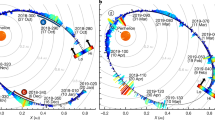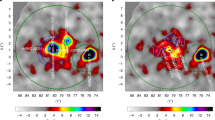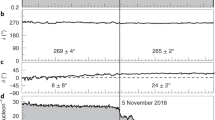Abstract
The spacecraft Voyager 1 is at a distance greater than 85 au from the Sun, in the vicinity of the termination shock that marks the abrupt slowing of the supersonic solar wind and the beginning of the extended and unexplored distant heliosphere1,2. This shock is expected to accelerate ‘anomalous cosmic rays’3, as well as to re-accelerate Galactic cosmic rays5 and low-energy particles from the inner Solar System4. Here we report a significant increase in the numbers of energetic ions and electrons that persisted for seven months beginning in mid-2002. This increase differs from any previously observed in that there was a simultaneous increase in Galactic cosmic ray ions and electrons, anomalous cosmic rays and low-energy ions. The low-intensity level and spectral energy distribution of the anomalous cosmic rays, however, indicates that Voyager 1 still has not reached the termination shock. Rather, the observed increase is an expected precursor event. We argue that the radial anisotropy of the cosmic rays is expected to be small in the foreshock region, as is observed.
This is a preview of subscription content, access via your institution
Access options
Subscribe to this journal
Receive 51 print issues and online access
$199.00 per year
only $3.90 per issue
Buy this article
- Purchase on Springer Link
- Instant access to full article PDF
Prices may be subject to local taxes which are calculated during checkout



Similar content being viewed by others
References
Parker, E. N. Interplanetary Dynamical Processes 115–128 (Interscience Division, John Wiley and Sons, New York, 1963)
Holzer, T. E. Interaction between the solar wind and the interstellar medium. Annu. Rev. Astron. Astrophys. 270, 199–234 (1989)
Pesses, M. E., Jokipii, J. R. & Eichler, D. Cosmic ray drift, shock wave acceleration and the anomalous component of cosmic rays. Astrophys. J. 246, L85–L88 (1981)
Mewaldt, R. Solar and interplanetary particles reaccelerated at the solar wind termination shock. Proc. 24th ICRC (Rome) 3, 804–807 (1995)
Jokipii, J. R., Kota, J. & Merenyi, E. The gradient of galactic cosmic rays at the solar wind termination shock. Astrophys. J. 405, 782–786 (1993)
Stone, E. C. et al. Cosmic ray investigations for the Voyager missions: Energetic particle studies in the outer heliosphere—and beyond. Space Sci. Rev. 21, 355–376 (1977)
Cummings, A. C., Stone, E. C. & Steenberg, C. D. Composition of anomalous cosmic rays and other interplanetary ions. Astrophys. J. 578, 194–210 (2002)
Cummings, A. C. et al. Voyager 1 observations of the anisotropies of enhanced MeV ion fluxes at 85au. Proc. 28th ICRC (Tsukuba) 7, 3777–3780 (2003)
Krimigis, S. M. et al. Voyager 1 left the solar wind at a distance of ∼85au from the Sun. Nature 426 45–48 (2003)
Jokipii, J. R., Giacalone, J. & Kota, J. Anomalous cosmic ray and plasma signatures of a termination shock crossing. Geophys. Res. Lett. (submitted)
Chalov, S. V. & Fahr, H. J. Pick-up ion acceleration at the termination shock and the post-shock pick-up ion energy distribution. Astron. Astrophys. 360, 381–390 (2000)
Jokipii, J. R. & Giacalone, J. Anomalous cosmic rays at a termination shock crossing. Proc. 28th ICRC (Tsukuba) 7, 3753–3756 (2003)
Burlaga, L. F. et al. Search for the heliosheath with Voyager 1 magnetic field measurements. Geophys. Res. Lett. (in the press)
Van Allen, J. A. & Fillius, R. W. Propagation of large Forbush decreases in cosmic ray intensity past the Earth, Pioneer 11 at 34au and Pioneer 10 at 53au. Geophys. Res. Lett. 19, 1423–1426 (1992)
Webber, W. R. & Lockwood, J. A. Giant transient decreases of cosmic rays in the outer heliosphere in September 1991. J. Geophys. Res. 98, 7821–7826 (1991)
Gurnett, D. A., Kurth, W. S., Allendorf, S. C. & Poynter, R. L. Radio emission from the heliopause triggered by an interplanetary shock. Science 262, 199–203 (1993)
Lukasiak, A. et al. The Voyager electron telescope—A status report. Proc. 26th ICRC (Salt Lake City) 3, 65–68 (1999)
Gloeckler, G. et al. Acceleration of interstellar pickup ions in the disturbed solar wind observed on Ulysses. J. Geophys. Res. 99, 17637–17643 (1994)
Schwadron, N. A. & McComas, D. J. Heliospheric “Falts”: Favored Acceleration Locations at the Termination Shock. Geophys. Res. Lett. 30, doi:10.1029/2002GLO16499 (2003)
Christon, S. P. & Stone, E. C. Latitude variation of recurrent MeV energy proton flux enhancements in the radial range 11–20au and possible correlation with solar coronal hole dynamics. Geophys. Res. Lett. 12, 109–112 (1985)
Acknowledgements
We thank J. D. Richardson and colleagues for making the Voyager 2 solar wind data available at 〈http://web.mit.edu/afs/athena/org/s/space/www/voyager.html〉. We also thank J. R. Jokipii, F. C. Jones, H. Moraal, V. Ptuskin and R. Caballero-Lopez for discussions on shock acceleration processes and particle flow in the vicinity of the acceleration region.
Author information
Authors and Affiliations
Corresponding author
Ethics declarations
Competing interests
The authors declare that they have no competing financial interests.
Rights and permissions
About this article
Cite this article
McDonald, F., Stone, E., Cummings, A. et al. Enhancements of energetic particles near the heliospheric termination shock. Nature 426, 48–51 (2003). https://doi.org/10.1038/nature02066
Received:
Accepted:
Issue Date:
DOI: https://doi.org/10.1038/nature02066
This article is cited by
-
The Heliospheric Termination Shock
Space Science Reviews (2013)
-
Cosmic-Ray Transport and Interaction with Shocks
Space Science Reviews (2013)
-
The Solar Wind in the Outer Heliosphere and Heliosheath
Space Science Reviews (2013)
-
The Dynamic Heliosphere: Outstanding Issues
Space Science Reviews (2009)
Comments
By submitting a comment you agree to abide by our Terms and Community Guidelines. If you find something abusive or that does not comply with our terms or guidelines please flag it as inappropriate.



